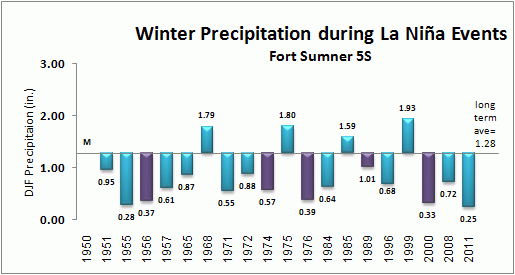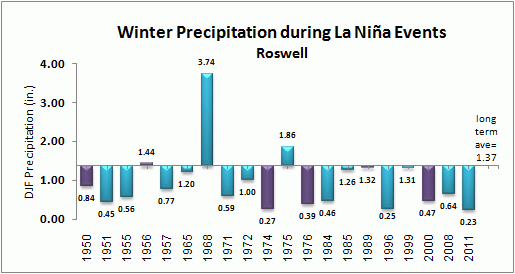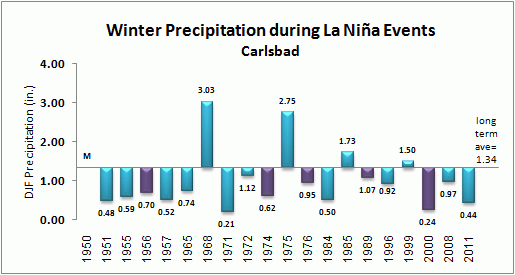Albuquerque, NM
Weather Forecast Office

| Southeastern Plains |
| December-January-February Precipitation |
|
(Return to Main Feature) or go to CD1 | CD2 | CD3 | CD4 | CD5 | CD6 | CD8 |
|
La Niña events impact the winter precipitation across southern New Mexico to a greater degree than other areas in the state. All three stations examined in this area reported DJF precipitation of 67% to 75% of the long term normal DJF. The reduction of precipitation is even more dramatic in strong La Niña events, especially in Fort Sumner. |
|
A description of the graphs is located at the bottom of the page. |
 |
| Percent of Longterm Average for all La Niña Events = 67% , for strong La Niña Events = 42% |
 |
| Percent of Longterm Average for all La Niña Events = 70% , for strong La Niña Events = 58% |
 |
| Percent of Longterm Average for all La Niña Events = 75% , for strong La Niña Events = 53% |
|
Precipitation values for 3-month periods during 19 La Niña Events since 1949-50 are plotted with respect to the long term precipitation average, listed to the right of the graph. The precipitation totals for each 3-month period are plotted above or below each bar. Years for which the La Niña Event was considered to be strong are colored in purple. "M" represents a 3-month period with missing data. Finally, the percents of longterm normal for all La Niña events and for the strong La Niña events are listed below each graph. |
Current Hazards
Outlooks
Submit A Storm Report
Severe and Hazardous Weather Info
Current Conditions
Surface Observations
Observed Precipitation
Satellite
Local Satellite Page
Local Observations Page
Map of Latest Wind and Precipitation Reports
Radar
National Radar
ABX Albuquerque Radar
FDX Cannon Air Force Base Radar
Forecasts
Fire Weather Forecasts
Area Forecast Discussion
Hourly View Forecast
Activity Planner
Aviation Forecasts
Local Forecast Page
Graphical Forecasts
Hydrology
Local Hydrology Products
Advanced Hydrologic Prediction Services
Climate and Past Weather
Drought
Severe T-Storm Climatology for NM
Local Data
Winter Climatology for NM
NOAA Climate Center
Climate Prediction Center
Climate Graphs
Local Programs
About Our Office
SKYWARN
NOAA Weather Radio
Local Studies and Features
Winter Weather Info, Safety Tips, and Climo
Severe Weather Info, Safety Tips, and Climo
Center Weather Service Unit
US Dept of Commerce
National Oceanic and Atmospheric Administration
National Weather Service
Albuquerque, NM
2341 Clark Carr Loop SE
Albuquerque, NM 87106-5633
(505) 243-0702
Comments? Questions? Please Contact Us.

